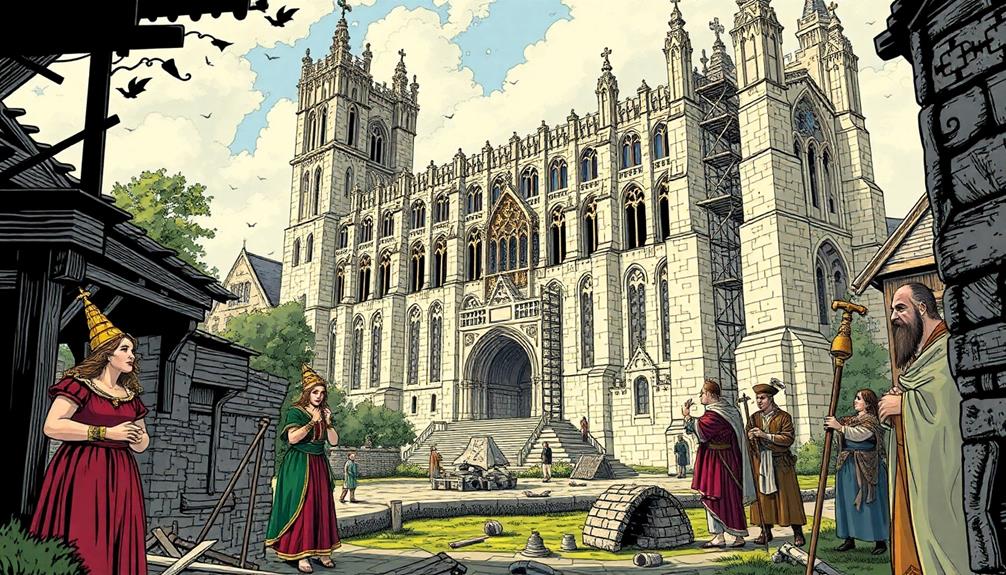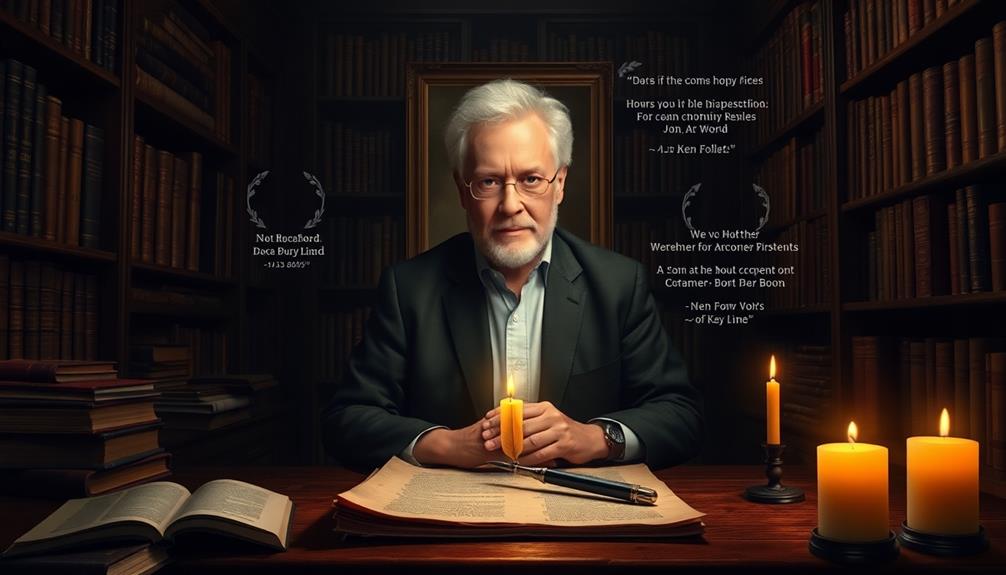You'll find that Ken Follett is the brilliant author behind "The Pillars of the Earth." This epic novel, published in 1989, transports you to 12th-century England, showcasing a dramatic narrative centered on the construction of a Gothic cathedral. Follett's journey as a writer involved overcoming skepticism about historical fiction, yet he crafted a story rich with themes of ambition, love, and power struggles. With well-developed characters facing societal challenges, the book has sold over 27 million copies worldwide. If you keep exploring, you'll uncover more about the profound impact Follett's work has had on historical fiction.
Overview of Ken Follett
Ken Follett, a master storyteller, was born on June 5, 1949, in Cardiff, Wales. He graduated with an Honours degree in Philosophy from University College, London, which laid the groundwork for his analytical thinking and narrative skills.
Before making his mark as a bestselling author, you'd find him working as a reporter and in publishing, gaining insights into the complexities of human experiences much like those explored in David Copperfield. These experiences helped him hone his storytelling abilities, preparing him for the literary world.
His breakthrough came in 1978 with the thriller novel "Eye of the Needle," which won the Edgar Award and established him as a significant voice in literature.
However, it was with "The Pillars of the Earth," published in 1989, that he made the shift into historical fiction. This monumental work has sold over 27 million copies worldwide, contributing to his impressive total of over 170 million sales across 36 books.
Ken Follett's writing features intricate plotting and deeply developed characters, merging historical accuracy with engaging narratives.
His unique style and storytelling prowess have influenced many authors across various genres, making him a pivotal figure in modern literature.
The Pillars of the Earth Synopsis
Follett's "The Pillars of the Earth" takes you on a sweeping journey through 12th-century England, where the construction of a Gothic cathedral in the fictional town of Kingsbridge serves as the narrative's backbone.
Spanning approximately 40 years, this historical fiction novel intricately weaves together the lives of its characters against a backdrop of social upheaval, civil war, and religious conflict. Much like Dickens' portrayal of 19th-century England's social realities in David Copperfield, Follett captures the essence of human resilience and personal growth amidst adversity.
As you explore the story, you'll witness the struggles of Tom Builder, a master builder dedicated to completing the cathedral, and Prior Philip, a reformist monk with a vision for Kingsbridge's future.
Lady Aliena, a noblewoman, fights fiercely to reclaim her family's honor amidst the chaos. Each character embodies themes of ambition, love, and the relentless power struggles of the time.
Ken Follett's meticulous attention to historical detail enriches the narrative, making "The Pillars of the Earth" a hallmark of the genre.
The resilience of the human spirit shines through as the characters navigate their intertwined fates, leaving you captivated by their journeys and the monumental cathedral that symbolizes hope and perseverance in an ever-changing world.
Key Characters and Their Roles

In "The Pillars of the Earth," you'll encounter key characters whose motivations drive the story forward.
Tom Builder and Prior Philip embody hope and moral integrity, representing the resilience of the human spirit, much like Louis Zamperini's survival in his own harrowing story.
Lady Aliena's strength shines through her struggles, as she navigates the challenges of her time.
On the other hand, William Hamleigh's ruthless ambition creates major obstacles, intensifying the conflict that shapes their lives.
Protagonists' Motivations and Goals
Often, characters in "The Pillars of the Earth" reveal their motivations through their ambitions and struggles, driving the narrative forward.
Tom Builder, for instance, embodies the spirit of creation as he endeavors to construct a magnificent cathedral. His ambition faces numerous personal and professional hurdles, yet his resilience highlights the challenges of artistic vision during a turbulent time.
Prior Philip, a reform-minded monk, shares Tom's goal of building the cathedral, but his motivations extend beyond mere construction. He aims to uplift the Kingsbridge community spiritually and economically, balancing his faith with practical leadership. His dedication reflects a deep commitment to both his beliefs and the welfare of those around him.
Lady Aliena's motivations stem from a desire to reclaim her family's honor after experiencing great loss. In a male-dominated society, she showcases remarkable strength and determination, seeking to protect her legacy while maneuvering her own ambitions.
Each protagonist's journey intertwines, illustrating how their individual goals contribute to the larger narrative, revealing the complexities of ambition, resilience, and the quest for fulfillment in an unforgiving world.
Antagonists and Their Impact
The antagonists in "The Pillars of the Earth" play essential roles that intensify the narrative's conflict and shape the protagonists' journeys. At the forefront, William Hamleigh embodies ambition and cruelty, relentlessly pursuing power and control over Kingsbridge. His actions create a turbulent environment for characters like Tom Builder and Aliena, driving them to confront their own limits.
Waleran Bigod, the manipulative bishop, leverages his religious authority to create obstacles, further complicating the protagonists' paths. His machinations add layers of intrigue, emphasizing the moral dilemmas faced by the characters.
Walter, a lesser antagonist, serves as a foil, showcasing the violent nature of the era and reflecting the chaotic backdrop against which the story unfolds.
The interplay between these antagonists and the protagonists highlights significant themes within the narrative:
- The relentless pursuit of power
- The complexity of morality
- The struggle for survival
- The interconnected fates of characters
- The impact of ambition on society
Ultimately, these antagonists are essential in defining the characters' arcs, illustrating how the quest for power can shape destinies in a historical context.
Themes and Motifs Explored
Exploring the intricate themes and motifs in Ken Follett's "The Pillars of the Earth" reveals a rich tapestry of human experience set against the backdrop of 12th-century England. The novel dives deep into power struggles, showcasing how ambition shapes the destinies of its characters. You see this vividly through the actions of William Hamleigh, whose relentless pursuit of power exploits the chaos of the time, impacting everyone around him.
The stories of strength and resilience in the face of adversity, such as those found in survival narratives, resonate similarly in Follett's work, illustrating the challenges faced by individuals aiming for change.
Strong female characters like Aliena and Ellen emerge as pivotal figures, challenging societal expectations and demonstrating incredible resilience. Their journeys illustrate the importance of agency in a male-dominated world, pushing the narrative forward and reshaping their communities in the process.
The building of a cathedral serves as a powerful symbol throughout the story, representing not just faith but the unity and perseverance of the people involved. As they confront various challenges, the cathedral becomes a representation of their collective efforts, illustrating how individual actions ripple through the community, affecting social and political dynamics over time.
Follett weaves these themes together, creating a compelling exploration of human nature, ambition, and the bonds that hold society together.
Historical Context and Accuracy

In "The Pillars of the Earth," you'll find yourself immersed in the tumultuous world of 12th-century England, where civil war shapes the characters' destinies.
Follett's commitment to architectural authenticity brings the grandeur of Gothic cathedrals to life, while the societal challenges reflect the era's complexities.
As you read, you'll notice how these elements intertwine, driving the narrative forward and highlighting the struggle for power during a pivotal time in history.
Medieval England Setting
Set against the backdrop of 12th-century England, Ken Follett's "The Pillars of the Earth" immerses you in a world rife with civil strife and power struggles between the monarchy and the church. The story spans about four decades, capturing the essence of medieval life as it unfolds amid the building of a medieval cathedral and the tumult of its time.
As you read, you'll encounter:
- The impact of the First Crusade on societal dynamics
- A vivid portrayal of class struggles and gender roles
- The influence of the church on everyday life
- The devastating effects of famine and political instability
- Real historical figures who shape the narrative
Follett masterfully blends historical accuracy with fiction, allowing you to grasp the complexities of this era. His attention to detail, from architectural principles of Gothic cathedrals to the intricacies of feudal society, enriches your understanding of the historical context.
While some modern sensibilities might seep in, the core of medieval England remains authentic, offering you an enthralling glimpse into the lives of those who lived during this transformative period.
Architectural Authenticity
Ken Follett's "The Pillars of the Earth" vividly captures the architectural authenticity of 12th-century Gothic cathedrals, immersing you in the intricate details of their construction. As you follow the narrative, you'll discover the meticulous building techniques and challenges faced during the creation of Kingsbridge Cathedral. Follett's extensive research shines through, showcasing the complexity involved in architectural endeavors of the time.
The cathedral stands as a powerful symbol of community and faith, reflecting its historical significance in medieval towns. You'll appreciate how these magnificent structures weren't just places of worship but also the heart of social life, embodying the church's influence.
While some historical inaccuracies exist, such as literacy rates, Follett effectively conveys the essence of the period, emphasizing the importance of architecture. His attention to detail in the construction process, the materials used, and the labor required enriches your understanding of medieval life.
You can almost envision the artisans and laborers working tirelessly, driven by a shared vision of creating something monumental. In "The Pillars of the Earth," architecture becomes a living narrative, connecting past and present in a compelling way.
Societal Challenges Depicted
Amid the turmoil of 12th-century England, "The Pillars of the Earth" illuminates the societal challenges that shaped life during this turbulent time. As you read, you'll witness the struggles of characters against the backdrop of civil war and the ambitions of power-hungry figures like William Hamleigh.
Follett captures the essence of the Middle Ages, depicting how the building of the cathedral becomes a symbol of hope amidst adversity.
Key societal challenges portrayed in the novel include:
- Political instability affecting daily life
- The impact of famine and storms on the population
- Class divisions and their consequences
- The role of ambition and personal greed in societal dynamics
- The resilience of communities facing hardships
Follett's detailed descriptions immerse you in medieval life, showcasing how these societal challenges influence the characters' actions and relationships.
While the narrative aims for historical accuracy, it does contain some discrepancies, especially regarding literacy rates and societal structures.
Ultimately, the novel emphasizes human resilience, illustrating how ambition, faith, and community support help individuals navigate the complexities of their time.
Character Development Insights
Follett crafts characters in "The Pillars of the Earth" that resonate deeply with readers, drawing you into their complex lives. His character development showcases relatable strengths and weaknesses that enhance their complexity, making you feel a genuine connection. This intricate exploration of human ambition and rivalry mirrors the intense dynamics found in stories like the rivalry of Kane and Abel.
Take Tom Builder, for example; he embodies the master builder archetype, maneuvering personal and professional challenges with resilience and ambition. His journey makes you root for his success.
Aliena's character arc emphasizes strength and determination as she fights to protect her family's legacy. Her struggles and triumphs provide strong female representation, inspiring you to admire her courage.
On the other hand, Prior Philip serves as the narrative's moral center, embodying practical religious beliefs and community support even amidst adversity. His ethical dilemmas invite you to contemplate morality in difficult situations.
The relationships among these characters, including antagonists like William Hamleigh, enrich the plot. Their interactions add layers of conflict and emotional investment, allowing you to engage with the story on a deeper level.
Follett's skillful character development makes each relationship feel authentic, ensuring that the complexity of their lives stays with you long after you've turned the last page.
Reception and Critical Acclaim

The impact of "The Pillars of the Earth" goes beyond its rich character development, resonating with readers and critics alike since its publication in 1989.
With an impressive average rating of 4.34 from over 781,000 ratings, it's clear that Ken Follett's work struck a chord. Critics have lauded him for his skill in blending historical accuracy with engaging storytelling, leading to its status as a bestseller.
In a similar vein, the importance of storytelling in conveying human experiences and resilience is a central theme in literature, as seen in works like the power of storytelling.
Key points about the reception and critical acclaim include:
- Intricate narrative structure that keeps readers engaged
- Emotional depth and suspenseful twists throughout the story
- Recognition of Follett's ability to create memorable characters
- Discussions around the portrayal of women and historical inaccuracies
- Lasting influence on the historical fiction genre, inspiring adaptations
While some critiques highlight areas for improvement, the overall reception of "The Pillars of the Earth" showcases Follett's remarkable talent.
The book continues to inspire a dedicated fanbase and solidifies his legacy as a master storyteller. Its critical acclaim and popularity reflect not only its quality but also its significant impact on literature.
Narrative Style and Techniques
In "The Pillars of the Earth," you'll notice how Ken Follett crafts suspenseful plot development that keeps you on the edge of your seat.
His rich historical detail immerses you in the world of medieval architecture, making each twist and turn feel authentic and engaging.
Much like in And Then There Were None, where intricate plotting creates an unforgettable experience, Follett's storytelling captivates your attention and deepens your connection to the characters and their journeys.
Suspenseful Plot Development
Suspenseful plot development in "The Pillars of the Earth" masterfully draws you into a world where multiple character arcs intertwine, creating a rich tapestry of tension and intrigue.
Ken Follett skillfully paces the narrative, ensuring each chapter ends with a cliffhanger that propels you forward, keen to discover what happens next. He employs the "butterfly effect," illustrating how seemingly minor actions lead to significant consequences, heightening the suspense.
The unexpected plot twists keep you on your toes, making it difficult to predict characters' fates. Follett's meticulous attention to each character arc contributes to a constantly shifting landscape of alliances and rivalries, immersing you deeper into the story.
- Cliffhangers that compel you to read on
- The butterfly effect showcasing interconnected fates
- Unforeseen plot twists that surprise and engage
- Intricate character arcs that evolve throughout the story
- Architectural details that heighten emotional stakes
As you navigate this complex narrative, the suspense envelops you, ensuring that every turn of the page feels like a leap into the unknown.
You'll find yourself invested in the characters' struggles, enthusiastically anticipating their next move.
Rich Historical Detail
Rich historical detail weaves through "The Pillars of the Earth," immersing you in the era of 12th-century England. Ken Follett's narrative style intricately intertwines the lives of multiple characters, allowing their individual stories to shape the overarching plot.
As you navigate through four decades of turmoil and triumph, you'll witness profound character development, which deepens your connection to their struggles and aspirations.
Follett's meticulous attention to architectural detail vividly brings the Gothic cathedral to life. You're not just reading about its construction; you're experiencing the painstaking processes and challenges faced by the builders.
This level of detail enhances your understanding of the historical context, making the cathedral a symbol of ambition and resilience in a time of great strife.
The novel's thrilling elements, combined with unexpected plot twists, keep you engaged throughout its expansive narrative. As characters evolve, themes of love, loss, and ambition resonate deeply, enriching the historical narrative.
Follett's ability to blend historical accuracy with emotional depth guarantees that you're not merely an observer but an active participant in the lives and times of Kingsbridge's inhabitants.
Follett's Writing Journey

Ken Follett's writing journey is a tribute to perseverance and creative evolution. Growing up in a Puritan religious group, he initially lacked exposure to architecture, yet it sparked a deep interest that would later define his work. In the face of societal expectations, his journey mirrors the resilience demonstrated by individuals in historical collective action, showcasing how determination can lead to remarkable achievements.
In 1976, Follett sketched the idea for "The Pillars of the Earth," but faced skepticism from his agent, who doubted its appeal. Despite this, he forged ahead, shifting from bestselling thrillers to historical fiction.
When "The Pillars of the Earth" was published in 1989, it became an instant bestseller, largely through word-of-mouth promotion. Follett is known worldwide for his ability to weave intricate narratives, and this novel revitalized the historical fiction genre. His meticulous research into cathedral architecture and medieval life brought the story to life, particularly the iconic Kingsbridge cathedral.
Here are some key aspects of his writing journey:
- Started writing after overcoming a restrictive upbringing
- Faced initial rejection regarding his historical fiction dreams
- Shifted from thrillers to historical narratives
- Conducted extensive research for authenticity
- Inspired readers worldwide through compelling storytelling
Reading this book offers a glimpse into Follett's remarkable evolution as a writer.
Adaptations and Cultural Impact
Follett's impressive storytelling in "The Pillars of the Earth" not only captivated readers but also sparked a wave of adaptations that expanded its reach and cultural significance.
The 2010 miniseries adaptation received critical acclaim for its faithful representation of Follett's narrative and characters, drawing in a wider audience who mightn't have explored the novel. Following this success, the sequel "World Without End" published in 2007, was also adapted into a television miniseries, further enriching the story's universe and enhancing its cultural impact.
In 2017, a video game launched, allowing players to immerse themselves in the historical setting and engage with beloved characters interactively.
Additionally, a musical adaptation titled "Jordens Søjler" premiered in Copenhagen in 2016, showcasing the themes of the story through a fresh artistic lens.
These adaptations have inspired numerous discussions and analyses surrounding the historical context and character dynamics, solidifying "The Pillars of the Earth" as a significant work in the domain of historical fiction.
Through these diverse formats, the story continues to resonate, proving its enduring relevance and impact in contemporary culture.
Conclusion
In the grand tapestry of Ken Follett's storytelling, "The Pillars of the Earth" stands as a towering cathedral—each character a stone, collectively supporting the narrative's arching themes of ambition and resilience. As you turn the pages, you uncover not just a tale of medieval strife but a reflection of your own struggles and triumphs. Just like the enduring structures within the novel, Follett's work reminds you that your journey, too, can withstand the test of time.



